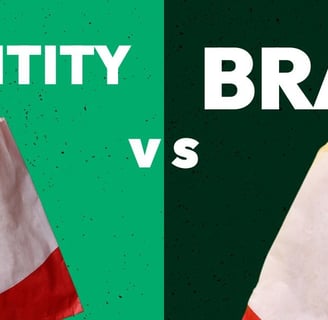Visual Identity vs. Branding: Understanding the Difference
BRANDING & MARKETINGSUSTAINABILITY, INNOVATION AND GROWTH STRATEGIES
3 min read


In the world of business and marketing, terms like "branding" and "visual identity" are often used interchangeably. While they are closely related and interdependent, they are not the same thing. Understanding the distinction between the two is crucial for any business aiming to build a strong, cohesive, and impactful presence in the market.
What is Branding?
As discussed previously, branding is the overarching strategy and the sum total of every interaction a customer has with your business. It's the intangible essence of your company – its personality, promise, reputation, and the emotional connection it builds with its audience. Branding defines:
Your Mission and Values: What your company stands for.
Your Unique Selling Proposition (USP): What makes you different.
Your Brand Voice: How you communicate (e.g., formal, friendly, authoritative).
Your Brand Story: The narrative behind your existence.
Customer Experience: How customers feel when they interact with your product, service, or team.
Branding is about shaping perceptions, building trust, and fostering loyalty. It's the strategic foundation upon which all other marketing and communication efforts are built.
What is Visual Identity?
Visual identity is a core component of your overall brand, but it's specifically about the visual elements that represent your brand. It's the tangible, visible expression of your brand's personality and values. Think of it as the face of your brand.
Key elements of visual identity include:
Logo: The primary symbol that represents your brand.
Color Palette: The specific set of colors used consistently across all brand materials.
Typography: The fonts chosen for headings, body text, and other communications.
Imagery & Photography Style: The type of photos, illustrations, or graphics that align with your brand's aesthetic.
Iconography: The style of icons used.
Graphic Elements: Patterns, shapes, and other design elements that create a cohesive look.
Layout & Composition Guidelines: Rules for how visual elements are arranged.
The purpose of visual identity is to create immediate recognition, convey your brand's message visually, and evoke specific emotions in your audience.
The Key Differences and Their Relationship
Here's a breakdown of how branding and visual identity differ and how they work together:
Visual identity is a part of branding, not a substitute for it. Your brand is the entire iceberg, while your visual identity is the visible tip.
Branding informs Visual Identity: Your brand's mission, values, and personality should dictate the choices made in your visual identity. For example, a brand focused on luxury and exclusivity would choose a visual identity that reflects sophistication and premium quality.
Visual Identity expresses Branding: The visual elements are the tools that communicate your brand's message and personality to the world. A well-designed logo, consistent colors, and appropriate typography help reinforce the brand's promise and differentiate it.
Consistency is Key: For a brand to be strong, its visual identity must be consistent across all touchpoints. This consistency builds familiarity and reinforces the brand's message. Without a strong underlying brand strategy, a beautiful visual identity might lack depth and fail to resonate with the audience. Conversely, a strong brand strategy without a compelling visual identity might struggle to be recognized or remembered.
Examples in Practice
Let's look at a few well-known brands to illustrate the distinction:
1. Apple
Branding: Apple's brand is built around innovation, simplicity, premium quality, user-friendliness, and a sense of aspirational lifestyle. They promise a seamless, intuitive experience and a product that integrates effortlessly into your life. Their brand evokes feelings of sophistication, creativity, and progress.
Visual Identity: This is expressed through their iconic bitten apple logo, minimalist design aesthetic (clean lines, white/silver/space gray color palettes), a distinct sans-serif typography (like San Francisco), and polished, often high-contrast photography that highlights product features and sleekness. Every product, store, and advertisement consistently reflects this visual language.
2. Nike
Branding: Nike's brand is about athletic achievement, inspiration, and empowerment. Their slogan "Just Do It" encapsulates their brand promise of pushing boundaries, overcoming challenges, and achieving greatness. They connect with consumers on an emotional level through stories of perseverance and victory.
Visual Identity: The "swoosh" logo is instantly recognizable globally. Their visual identity also includes a bold, dynamic typography, a primary color palette often featuring black, white, and vibrant accents, and action-oriented photography that showcases athletes in motion, emphasizing strength and determination.
3. Coca-Cola
Branding: Coca-Cola's brand is synonymous with happiness, refreshment, sharing, and timeless American tradition. They aim to evoke feelings of joy, nostalgia, and a sense of connection. Their brand story is deeply rooted in celebration and everyday moments.
Visual Identity: Their visual identity is characterized by the distinctive Spencerian script logo, the iconic "Coca-Cola Red" color, the unique contour bottle shape, and classic, often celebratory imagery featuring diverse groups of people enjoying their product.
In each of these examples, you can see how the visual identity (what you see) is a powerful tool that consistently communicates and reinforces the deeper brand (what you feel and believe about the company).
Conclusion
While often confused, branding and visual identity play distinct yet complementary roles in establishing a successful business. Branding is the soul and strategy of your company, defining its essence and promise. Visual identity is the face and aesthetic representation, making your brand recognizable and memorable. Together, they form a powerful duo that can elevate your business, attract your target audience, and build lasting relationships.


